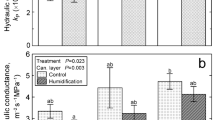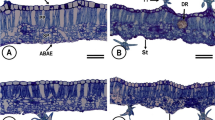Abstract
This study assessed the variation of leaf anatomy, chlorophyll content index (CCI), maximal stomatal conductance (g maxs ) and leaf wettability within the canopy of an adult European beech tree (Fagus sylvatica L.) and for beech saplings placed along the vertical gradient in the canopy. At the top canopy level (CL28m) of the adult beech, CCI and leaf anatomy reflected higher light stress, while g maxs increased with height, reflecting the importance of gas exchange in the upper canopy layer. Leaf wettability, measured as drop contact angle, decreased from 85.5° ± 1.6° (summer) to 57.5° ± 2.8° (autumn) at CL28m of the adult tree. At CL22m, adult beech leaves seemed to be better optimized for photosynthesis than the CL28m leaves because of a large leaf thickness with less protective and impregnated substances, and a higher CCI. The beech saplings, in contrast, did not adapt their stomatal characteristics and leaf anatomy according to the same strategy as the adult beech leaves. Consequently, care is needed when scaling up experimental results from seedlings to adult trees.





Similar content being viewed by others
Abbreviations
- Ab:
-
Adaxial
- Ad:
-
Adaxial
- CLxm :
-
Canopy level at x meter
- CCI:
-
Chlorophyll content index
- DCA:
-
Drop contact angle
- Fv/Fm:
-
Maximum quantum efficiency of photosystem II
- g maxs :
-
Maximal stomatal conductance
- K :
-
Coefficient of palisadeness
- Rs:
-
Stomatal resistance
- SPS:
-
Stomatal pore surface
References
Adriaenssens S, Staelens J, Wuyts K, De Schrijver A, Van Wittenberghe S, Wuytack T, Kardel F, Verheyen K, Samson R, Boeckx P (2011) Foliar nitrogen uptake from wet deposition and the relation with leaf wettability and water storage capacity. Water Air Soil Pollut 219:43–57
Baker EA (1982) Chemistry and morphology of plant epicuticular waxes. In: Cutler DJ, Alvin KL, Price CE (eds) The plant cuticle. Academic Press, London, pp 139–165
Balasooriya BLWK, Samson R, Mbikwa F, Vitharana UWA, Boeckx P, Van Meirvenne M (2009) Biomonitoring of urban habitat quality by anatomical and chemical leaf characteristics. Environ Exp Bot 65:386–394
Brewer CA (1996) What’s so bad about being wet all over—investigating leaf surface wetness. Am Biol Teach 58:414–417
Burkhardt J, Eiden R (1994) Thin water films on coniferous needles. Atmos Environ 28:2001–2011
Burkhardt J, Flechard CR, Gresens F, Mattsson M, Jongejan PAC, Erisman JW, Weidinger T, Meszaros R, Nemitz E, Sutton MA (2009) Modelling the dynamic chemical interactions of atmospheric ammonia with leaf surface wetness in a managed grassland canopy. Biogeosciences 6:67–84
Burkhardt J (2010) Hygroscopic particles on leaves: nutrients or desiccants? Ecol Monogr 80:369–399
Bussotti F (2008) Functional leaf traits, plant communities and acclimation processes in relation to oxidative stress in trees: a critical overview. Glob Change Biol 14:2727–2739
Bussotti F, Gravano E, Grossoni P, Tani C (1998) Occurrence of tannins in leaves of beech trees (Fagus sylvatica) along an ecological gradient, detected by histochemical and ultrastructural analyses. New Phytol 138:469–479
Cape JN (2008) Interactions of forests with secondary air pollutants: some challenges for future research. Environ Pollut 155:391–397
de Pury DGG, Farquhar GD (1999) A commentary on the use of a sun/shade model to scale from the leaf to a canopy. Agric Forest Meteorol 95:257–260
Dietz J, Leuschner C, Holscher D, Kreilein H (2007) Vertical patterns and duration of surface wetness in an old-growth tropical montane forest, Indonesia. Flora 202:111–117
Dineva SB (2004) Comparative studies on the leaf morphology and structure of white ash Fraxinus americana L. and London plane tree Platanus acerifolia Willd growing in pollutes area. Dendrobiology 52:3–8
Dineva SB (2006) Development of the leaf blades of Acer platanoides in industrially contaminated environment. Dendrobiology 52:3–8
Eensalu E, Kupper P, Sellin A, Rahi M, Sober A, Kull O (2008) Do stomata operate at the same relative opening range along a canopy profile of Betula pendula? Funct Plant Biol 35:103–110
Erisman JW, Draaijers G (2003) Deposition to forests in Europe: most important factors influencing dry deposition and models used for generalisation. Environ Pollut 124:379–388
Farquhar GD, Wong SC, Evans JR, Hubick KT (1989) Photosynthesis and gas exchange. In: Jones HG, Flowers TJ, Jones MB (eds) Plants under stress. Cambridge University Press, Cambridge, pp 47–69
Fritsche U, Gernert M, Schindler C (1989) Vertical profiles of air-pollutants in a spruce forest—analysis of adherent water, throughfall and deposits on surrogate surfaces. Atmos Environ 23:1807–1814
Gerosa G, Marzuoli R, Bussotti F, Pancrazi M, Ballarin-Denti A (2003) Ozone sensitivity of Fagus sylvatica and Fraxinus excelsior young trees in relation to leaf structure and foliar ozone uptake. Environ Pollut 125:91–98
Gessler A, Rienks M, Rennenberg H (2000) NH3 and NO2 fluxes between beech trees and the atmosphere—correlation with climatic and physiological parameters. New Phytol 147:539–560
Gostin IN (2009) Air pollution effects on the leaf structure of some Fabaceae species. Not Bot Hortic Agrobot 37:57–63
Grossoni P, Bussotti F, Tani C, Gravano E, Santarelli S, Bottacci A (1998) Morpho-anatomical alterations in leaves of Fagus sylvatica L. and Quercus ilex L. in different environmental stress condition. Chemosphere 36:919–924
Hallik L, Kull O, Niinemets U, Aan A (2009) Contrasting correlation networks between leaf structure, nitrogen and chlorophyll in herbaceous and woody canopies. Basic Appl Ecol 10:309–318
Hansen K (1996) In-canopy throughfall measurements of ion fluxes in Norway spruce. Atmos Environ 30:4065–4076
Hansen U, Fiedler B, Rank B (2002) Variation of pigment composition and antioxidative systems along the canopy light gradient in a mixed beech/oak forest: a comparative study on deciduous tree species differing in shade tolerance. Trees Struct Funct 16:354–364
Herbinger K, Then C, Low M, Haberer K, Alexous M, Koch N, Remele K, Heerdt C, Grill D, Rennenberg H, Haberle KH, Matyssek R, Tausz M, Wieser G (2005) Tree age dependence and within-canopy variation of leaf gas exchange and antioxidative defence in Fagus sylvatica under experimental free-air ozone exposure. Environ Pollut 137:476–482
Holloway PJ (1969) Chemistry of leaf waxes in relation to wetting. J Sci Food Agr 20:124–128
Kardel F, Wuyts K, Babanezhad M, Vitharana UWA, Wuytack T, Potters G, Samson R (2010) Assessing urban habitat quality based on specific leaf area and stomatal characteristics of Plantago lanceolata L. Environ Pollut 158:788–794
Kardel F, Wuyts K, Babanezhad M, Wuytack T, Adriaenssens S, Samson R (2012) Tree leaf wettability as passive bio-indicator of urban habitat quality. Environ Exp Bot 75:277–285
Klemm O, Milford C, Sutton MA, Spindler G, van Putten E (2002) A climatology of leaf surface wetness. Theor Appl Climatol 71:107–117
Kolb TE, Fredericksen TS, Steiner KC, Skelly JM (1997) Issues in scaling tree size and age responses to ozone: a review. Environ Pollut 98:195–208
Kolb TE, Matyssek R (2001) Limitations and perspectives about scaling ozone impacts in trees. Environ Pollut 115:373–392
Kupcinskiene E, Huttunen S (2005) Long-term evaluation of the needle surface wax condition of Pinus sylvestris around different industries in Lithuania. Environ Pollut 137:610–618
Lake JA, Quick WP, Beerling DJ, Woodward FI (2001) Plant development—signals from mature to new leaves. Nature 411:154
Lamaud E, Carrara A, Brunet Y, Lopez A, Druilhet A (2002) Ozone fluxes above and within a pine forest canopy in dry and wet conditions. Atmos Environ 36:77–88
Larcher W (2003) Plants under stress. In: Larcher W (ed) Physiological plant ecology, 4th edn. Springer, Berlin, pp 345–450
Lichtenthaler HK, Ač A, Marek MV, Kalina J, Urban O (2007) Differences in pigment composition, photosynthetic rates and chlorophyll fluorescence images of sun and shade leaves of four tree species. Plant Physiol Bioch 45:577–588
Lovett GM, Lindberg SE (1992) Concentration and deposition of particles and vapors in a vertical profile through a forest canopy. Atmos Environ 26:1469–1476
Meidner H (1986) Cuticular conductance and the humidity response of stomata. J Exp Bot 37:517–525
Meinzer FC, Clearwater MJ, Goldstein G (2001) Water transport in trees: current perspectives, new insights and some controversies. Environ Exp Bot 45:239–262
Mussche S, Samson R, Nachtergale L, De Schrijver A, Lemeur R, Lust N (2001) A comparison of optical and direct methods for monitoring the seasonal dynamics of leaf area index in deciduous forests. Silva Fenn 35:373–384
Neirynck J, Genouw G, Coenen S, Roskams P (2004) Depositie en luchtkwaliteit in Vlaamse bosgebieden. Institute for Forestry and Game Management, No. IBW 2004-1, Geraardsbergen, Belgium
Niinemets U (2007) Photosynthesis and resource distribution through plant canopies. Plant Cell Environ 30:1052–1071
Niinemets U, Valladares F (2004) Photosynthetic acclimation to simultaneous and interacting environmental stresses along natural light gradients: optimality and constraints. Plant Biol 6:254–268
Padgett PE, Cook H, Bytnerowicz A, Heath RL (2009) Foliar loading and metabolic assimilation of dry deposited nitric acid air pollutants by trees. J Environ Monitor 11:75–84
Pandey S, Nagar PK (2002) Leaf surface wetness and morphological characteristics of Valeriana jatamansi grown under open and shade habitats. Biol Plantarum 45:291–294
Parlange J-Y, Waggoner PE (1970) Stomatal dimensions and resistance to diffusion. Plant Physiol 46:337–342
Reig-Arminana J, Calatayud V, Cervero J, Garcia-Breijo FJ, Ibars A, Sanz MJ (2004) Effects of ozone on the foliar histology of the mastic plant (Pistacia lentiscus L.). Environ Pollut 132:321–331
Rennenberg H, Gessler A (1999) Consequences of N deposition to forest ecosystems—recent results and future research needs. Water Air Soil Pollut 116:47–64
Sase H, Takahashi A, Sato M, Kobayashi H, Nakata M, Totsuka T (2008) Seasonal variation in the atmospheric deposition of inorganic constituents and canopy interactions in a Japanese cedar forest. Environ Pollut 152:1–10
Schreuder MDJ, van Hove LWA, Brewer CA (2001) Ozone exposure affects leaf wettability and tree water balance. New Phytol 152:443–454
Terashima I, Hanba YT, Tazoe Y, Vyas P, Yano S (2006) Irradiance and phenotype: comparative eco-development of sun and shade leaves in relation to photosynthetic CO2 diffusion. J Exp Bot 57:343–354
Tukey HB (1970) Leaching of substances from plants. Ann Rev Plant Physiol 21:305–324
Turunen M, Huttunen S (1990) A review of the response of epicuticular wax of conifer needles to air-pollution. J Environ Qual 19:35–45
Vogelmann TC, Nishio JN, Smith WK (1996) Leaves and light capture: light propagation and gradients of carbon fixation within leaves. Trends Plant Sci 1:65–70
Warren CR (2008) Stand aside stomata, another actor deserves centre stage: the forgotten role of the internal conductance to CO2 transfer. J Exp Bot 59:1475–1487
Warren CR, Low M, Matyssek R, Tausz M (2007) Internal conductance to CO2 transfer of adult Fagus sylvatica: variation between sun and shade leaves and due to free-air ozone fumigation. Environ Exp Bot 59:130–138
Wieser G, Hecke K, Tausz M, Haberle KH, Gramsc TEE, Matyssek R (2003) The influence of microclimate and tree age on the defense capacity of European beech (Fagus sylvatica L.) against oxidative stress. Ann Forest Sci 60:131–135
Wuytack T, Verheyen K, Wuyts K, Kardel F, Adriaenssens S, Samson R (2010) The potential of biomonitoring of air quality using leaf characteristics of white willow (Salix alba L.). Environ Monit Assess 171:197–204
Acknowledgments
The authors wish to thank Em. Prof. Dr. Roland Caubergs for the preparation of the leaf cross sections and Luc Willems for field assistance. We are also grateful to the members of the Phytopathology Lab of Ghent University for the use of their microscopic equipment. The research presented in this paper is funded by the Belgian Science Policy Office in the frame of the STEREO II programme—project BIOHYPE (SR/00/131), in which the S. Van Wittenberghe is involved. S. Adriaenssens and J. Staelens are granted by a research project (G.0205.08N) and a postdoctoral fellowship of the Research Foundation, Flanders (FWO), respectively.
Author information
Authors and Affiliations
Corresponding author
Additional information
Communicated by T. Grams.
Rights and permissions
About this article
Cite this article
Van Wittenberghe, S., Adriaenssens, S., Staelens, J. et al. Variability of stomatal conductance, leaf anatomy, and seasonal leaf wettability of young and adult European beech leaves along a vertical canopy gradient. Trees 26, 1427–1438 (2012). https://doi.org/10.1007/s00468-012-0714-7
Received:
Revised:
Accepted:
Published:
Issue Date:
DOI: https://doi.org/10.1007/s00468-012-0714-7




